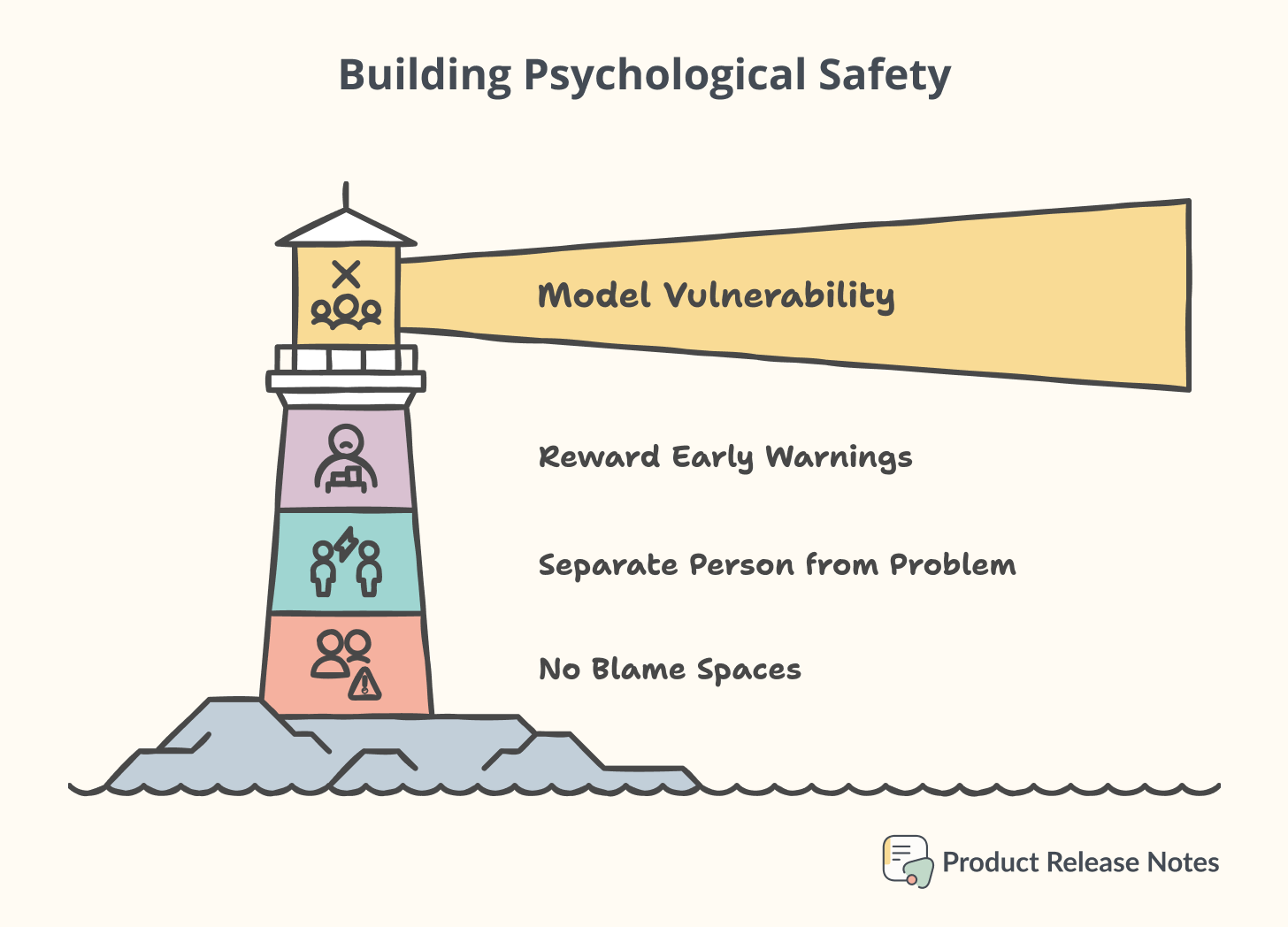Why Your Developers Aren't Raising Red Flags (And How To Fix It)
Your development team hides problems affecting the entire product. Here's how to create a culture where raising issues in advance becomes second nature and not a one-off event.
It's just days before a major release when a developer timidly admits that he's been:
A) Struggling with a critical bug for days/weeks
B) The enhancement or resolution was incomplete
C) A third-party library has introduced unexpected behavior
D) Another developer deleted/altered his code
E) Encountered performance issues that could lead to serious slowdowns
F) Any other scenario like this
You realize that now there is no way to meet the deadline, but at the same time you wonder why he didn't mention anything to you when there was time.
This scenario, painful as it may seem, is all too familiar in the technology industry, and highlights a fundamental problem faced by many development teams: a lack of open communication and a culture that discourages voicing concerns.
When developers refrain from raising red flags, it can lead to bigger problems down the line, including delayed releases, increased technical debt, and ultimately, a decrease in product quality.
🚨 The cost of these communication failures goes way beyond just missed deadlines—it erodes trust, damages team morale, and can poison your entire product culture.
So why aren't developers speaking up when they should? And more importantly, what can we as product managers do to fix it?
The Domino Effect of Unreported Delays
When developers keep issues to themselves, the consequences ripple throughout your entire organization:
🔄 Cascading Dependencies
One unreported delay triggers a domino effect across teams. QA can't test, marketing can't prepare materials, and sales sets incorrect customer expectations. What started as one person's problem becomes everyone's crisis.
💰 Financial Impact
The numbers don't lie:
Missed market windows costing thousands (sometimes millions) in revenue.
Emergency resources allocated at premium rates.
Potential penalties with clients or damaged reputation in the market.
👥 Team Morale
Perhaps the most insidious cost is the hit to team dynamics:
Trust erodes between developers and managers.
Finger-pointing replaces collaboration.
Future estimates become increasingly padded from fear.
But here's what's, somehow, fascinating: this isn't primarily a technical problem—it's a human one.
Why Developers Stay Silent (Even When They Shouldn't)
Understanding the psychology behind why talented developers don't speak up is the first step to solving the problem.
🧠 The Fear Factor
Fear of Blame:
"If I admit I'm stuck, they'll think I'm incompetent or not working hard enough."
Many developers worry that admitting challenges will reflect poorly on their skills. This fear is particularly strong in high-performing teams where everyone wants to appear capable.
Optimism Bias:
"I can figure this out if I just have a few more hours... or days..."
Developers are natural problem-solvers with a tendency toward optimism. They genuinely believe they're on the verge of a breakthrough, continuously extending their mental deadline.
Unclear Escalation Thresholds:
"When does this become a 'real problem' worth mentioning?"
Without clear guidelines for when to raise an issue, developers are left guessing. Is a one-day delay worth reporting? Three days? A week?
Previous Negative Experiences:
"Last time I raised a concern, I got extra scrutiny and micromanagement."
If speaking up previously led to negative consequences (even well-intentioned ones like increased oversight), developers learn that silence is safer.
💡 Pro Tip: Consider how you've responded to bad news in the past. Even subtle negative reactions can teach your team that problems should stay hidden.
Building Psychological Safety
Before implementing any frameworks or processes, you need to create an environment where developers feel safe speaking up. Here's how:
1. Model Vulnerability First
Start by admitting your own mistakes and challenges. When a product manager says, "I totally underestimated the complexity of this integration," it gives others permission to be honest.
2. Reward Early Warning Signs
When someone raises an issue early, make it a positive experience:
"Thank you for bringing this to our attention so quickly."
"This is exactly what we need—early visibility into potential problems."
3. Separate the Person from the Problem
Frame discussions around the issue, not the individual:
❌ Instead of: "Why didn't you complete this on time?"
✅ Try: "What obstacles are we facing with this feature?"
4. Create Dedicated "No Blame" Spaces
Establish regular forums specifically for surfacing risks without judgment:
Risk review sessions where everyone shares their concerns.
Anonymous submission channels for those still building confidence.
Being assertive is challenging, here's a quick guide on how to make sure your messages come across well:
Communication Frameworks That Work
Now for the practical stuff! Here are communication frameworks you can start implementing in your team:
🚦 The Traffic Light Status Update
Teach developers to include a simple status indicator in every update:
🟢 GREEN: On track, no issues
🟡 YELLOW: At risk, facing challenges but still hopeful
🟠 ORANGE: Serious concerns, need help to get back on track
🟥 RED: Blocked, cannot proceed without intervention
The beauty of this system is its simplicity. It removes the emotional burden of admitting problems by making status reporting objective and routine.
⏱️ The 3-Day Rule
Implement a policy where any developer stuck on the same problem for more than three days MUST raise it to the team. This removes the guesswork about when to speak up.
This is effective because:
It's long enough to avoid unnecessary escalations.
It's short enough to prevent major timeline impacts.
It creates a clear, objective trigger for action.
📋 The Structured Blocker Report Template
When issues do arise, having a clear template reduces friction in reporting:
BLOCKER REPORT
Issue: [Brief description of the problem]
Impact: [What features/components are affected]
Timeline: [How long it's been an issue, deadline implications]
Attempted Solutions: [What's been tried already]
Help Needed: [Specific assistance or resources required]
Proposed Next Steps: [Developer's recommendation]This structure:
Makes reporting feel less like "complaining" and more like problem-solving.
Ensures all necessary information is captured.
Demonstrates the developer's proactive approach.
💬 Daily Micro-Check-ins
Replace the standard "What did you do yesterday? What will you do today?" standup format with these three questions:
"What's your confidence level (1-10) in meeting your current deadlines?"
"What's the biggest risk to your work right now?"
"What would help you move faster or more confidently?"
These questions naturally surface concerns while giving developers an easy opening to discuss challenges.
Making It a Habit
Individual frameworks are helpful, but creating lasting change requires embedding these practices into your team's DNA:
1. Celebration Rituals
Create positive reinforcement for early reporting:
"Bug Catcher of the Month" recognition.
Celebrate "saves" where early reporting prevented issues.
Share success stories of how early communication led to better outcomes.
2. Leadership Accountability
Hold yourself and other leaders accountable:
Track and review your own reactions to bad news.
Ask for feedback on how approachable you are.
Make "psychological safety" part of leadership evaluations.
3. Onboarding Integration
Bake these expectations into how you bring new team members on board:
Make communication expectations clear from day one.
Pair new hires with "communication buddies" who model good reporting.
Include risk reporting scenarios in onboarding exercises.
Real Talk: This Takes Time ⏳
Building a culture of transparent communication won't happen overnight. There will be awkward conversations, mistakes, and growing pains. But stick with it, the alternative is far more painful. Remember:
A team that communicates problems early hits their deadlines more consistently than a team that avoids difficult conversations.
As product managers, we often focus on technical skills and processes, but creating psychological safety might be the most important "feature" you can build for your team.
Your communication culture starts now!
Ready to transform how your team communicates? Start small:
Choose one framework from this article to implement next week
Schedule a team discussion about communication barriers
Be the first to model vulnerability by sharing your own challenges
The first step is the hardest, but also the most important.
What communication challenges is your dev team facing? Which of these techniques have you tried? Drop your thoughts in the comments. I'd love to hear about your experiences! 👇











Often times, management only says “they’re quiet and shy” and the unspoken feedback just reflects lack of trust or incorrect effort measures. Because in the other side, Devs are not introduced effectively to a communication flow except for daily stand ups or slack engineering channels…. So all these suggestions on your post are great to get started 🙌